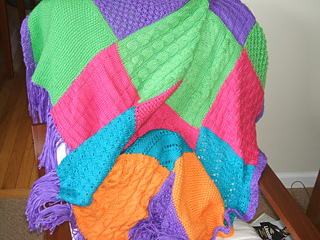patterns > Caron >  Caron International Yarns and 1 more...
Caron International Yarns and 1 more...
> Soften Your Mornings Afghan

Soften Your Mornings Afghan
Archived pdf:
http://web.archive.org/web/20100925194820/http://caron.co...
Skill level: Intermediate
MATERIALS:
Caron International’s Simply Soft Brites (discontinued)
(100% acrylic; 6 oz/170 g, 315 yds/288 m skein):
#9604 Watermelon (A), 2 skeins
#9605 Mango (B), 2 skeins
#9607 Limelight (C), 2 skeins
#9608 Blue Mint (D), 2 skeins
#9610 Grape (E), 3 skeins
5 colors, 11 balls total
One pair each size US 6, 8 and 9 (4, 5 and 5.5 mm), or size to obtain gauge
Cable needle (cn)
One circular needle size US 8 (5 mm), 24” or longer, for the borders
Yarn needle
Row counter (optional)
GAUGE
In Stockinette stitch, 18 sts x 24 rows = 4”/10cm, using medium (size 8) needles;
In Garter stitch, 4-1/2 sts =1” and 4 rows = 1/2”, using smallest (size 6) needles;
In Cable patterns, 17 sts x 20 rows = 4”/10cm, using largest (size 9) needles
PATTERNS
Seed Stitch
Trinity Stitch
Basket Stitch
Feather Stitch
Shell Stitch
Squares Stitch
6-Stitch Cable Pattern
Oblique Stitch
Ridge/Diamond Stitch
Horseshoe Cable Pattern
Alternate Eyelet Stitch
Mock Turkish Stitch
Double Moss Stitch
Campanula Stitch
Bamboo Stitch
Construction schematic and pattern charts are provided.
From the pattern:
Throw is worked in 5 Strips, with 5 different Stitch patterns per Strip (see diagram and text).
Gauge may vary slightly with the various Stitch patterns used for the Throw. Gauge is not critical for the overall piece, but it is important to maintain a consistent width on each Strip.
Stitch counts vary in individual Stitch patterns to help maintain a consistent width for each Strip.
Each block in each Strip is separated by 4 rows of Garter stitch; Garter st is worked with smallest (size 6) needles to maintain consistent width.
Cable Blocks (7, 10, 16 and 19) are worked using largest (size 9) needles to maintain consistent width; all other Blocks are worked with medium (size 8) needles.
Most Blocks have edge sts worked in St st throughout to make seaming easier (see Charts and text).
Borders are worked back and forth in rows; circular needle is used to accommodate large number of sts.
14430 projects
stashed
5261 times
- First published: July 2007
- Page created: December 14, 2007
- Last updated: February 11, 2023 …
- visits in the last 24 hours
- visitors right now







